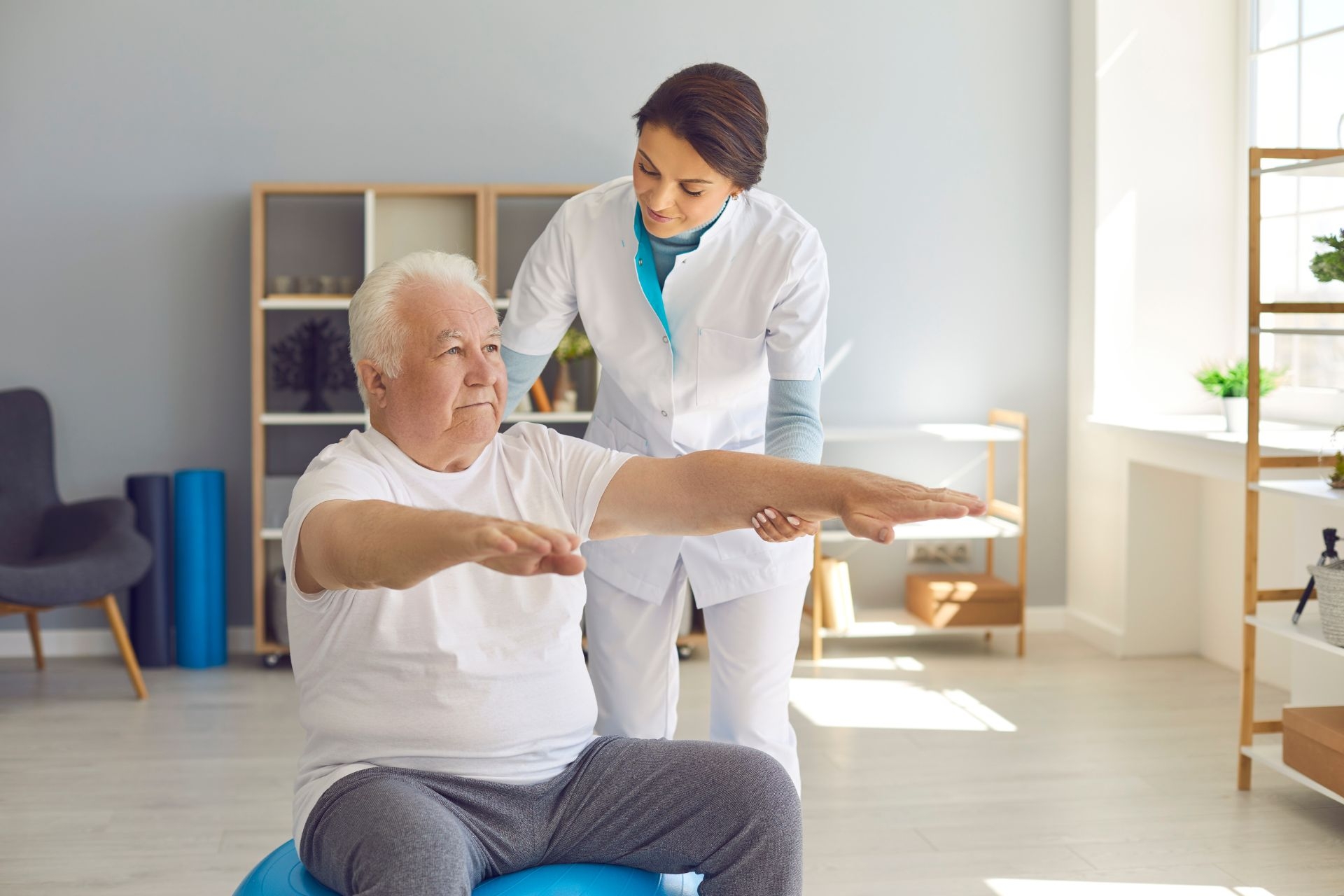

Proprioceptive neuromuscular facilitation (PNF) improves flexibility and range of motion by utilizing specific techniques that target the neuromuscular system. PNF involves a combination of stretching and contracting muscles to increase their extensibility and decrease muscle tension. This is achieved through the activation of proprioceptors, which are sensory receptors that provide information about body position and movement. By engaging these proprioceptors, PNF helps to reset the muscle's length-tension relationship, allowing for greater flexibility and range of motion.
There are several techniques used in proprioceptive neuromuscular facilitation (PNF). The most commonly used techniques include hold-relax, contract-relax, and rhythmic stabilization. In the hold-relax technique, the muscle is stretched to its end range and then held isometrically for a few seconds before relaxing and moving into a deeper stretch. The contract-relax technique involves contracting the muscle being stretched against resistance for a few seconds before relaxing and moving into a deeper stretch. Rhythmic stabilization involves alternating isometric contractions of opposing muscle groups to improve joint stability and range of motion.
Proprioceptive neuromuscular facilitation (PNF) is highly beneficial in rehabilitation and injury prevention. PNF techniques can help restore normal movement patterns and improve muscle imbalances, which are common after an injury or during the rehabilitation process. By targeting specific muscles and joints, PNF can enhance proprioception, coordination, and strength, which are essential for preventing future injuries. Additionally, PNF can help improve muscle flexibility and range of motion, allowing individuals to regain functional movement and reduce the risk of re-injury.

Incorporating proprioceptive neuromuscular facilitation (PNF) into a fitness routine offers numerous benefits. PNF can significantly improve flexibility and range of motion, allowing individuals to perform exercises with a greater range of motion and efficiency. This can lead to improved athletic performance and reduced risk of injury. PNF also helps to enhance muscle strength and coordination, as it involves both stretching and contracting muscles. By engaging the neuromuscular system, PNF can improve muscle activation and recruitment, leading to increased strength and improved movement patterns.
Proprioceptive neuromuscular facilitation (PNF) enhances muscle strength and coordination through its unique combination of stretching and contracting muscles. PNF techniques involve activating both the agonist and antagonist muscles, which helps to improve muscle balance and coordination. By engaging the neuromuscular system, PNF can also enhance muscle activation and recruitment, leading to increased strength. Additionally, PNF can improve proprioception, which is the body's ability to sense its position and movement in space. This improved proprioception can further enhance muscle coordination and overall movement quality.

When using proprioceptive neuromuscular facilitation (PNF), there are certain contraindications and precautions to consider. PNF should be avoided in cases of acute injuries, fractures, or severe pain. It is important to consult with a healthcare professional before starting PNF, especially if you have any pre-existing medical conditions or injuries. It is also crucial to perform PNF techniques under the guidance of a qualified professional to ensure proper technique and prevent any potential injuries. Additionally, individuals with certain medical conditions, such as hypertension or cardiovascular disease, may need to modify or avoid certain PNF techniques.
Proprioceptive neuromuscular facilitation (PNF) differs from other stretching techniques such as static stretching or dynamic stretching in several ways. Unlike static stretching, which involves holding a stretch for an extended period, PNF incorporates both stretching and contracting muscles. This combination of stretching and contracting helps to reset the muscle's length-tension relationship and improve flexibility and range of motion. PNF also differs from dynamic stretching, which involves moving through a full range of motion in a controlled manner. While dynamic stretching focuses on warming up the muscles and preparing them for activity, PNF targets specific muscles and joints to improve flexibility, strength, and coordination.

Biofeedback is a valuable tool in pelvic floor rehabilitation due to its numerous benefits. By providing real-time information about muscle activity and tension levels, biofeedback allows individuals to gain a better understanding of their pelvic floor muscles and how to control them effectively. This information can help patients develop awareness and coordination of their pelvic floor muscles, leading to improved muscle strength and function. Additionally, biofeedback can assist in identifying and correcting faulty muscle patterns or imbalances, promoting proper muscle recruitment and relaxation. The use of biofeedback in pelvic floor rehabilitation also empowers patients to actively participate in their treatment, as they can visualize their progress and make adjustments accordingly. Overall, biofeedback enhances the effectiveness of pelvic floor rehabilitation by providing objective feedback and promoting patient engagement in their own healing process.
Physical therapists can address musculoskeletal issues associated with computer workstation ergonomics by conducting a comprehensive assessment of the individual's posture, movement patterns, and workstation setup. They may recommend adjustments to the chair height, desk height, and monitor position to ensure proper alignment of the spine, neck, and wrists. Additionally, they may provide exercises and stretches to improve muscle strength and flexibility, targeting specific areas such as the neck, shoulders, and wrists. By addressing these ergonomic factors and providing targeted interventions, physical therapists can help individuals alleviate pain and discomfort associated with prolonged computer use and promote musculoskeletal health.
Blood flow restriction training, also known as occlusion training, has been shown to have positive effects on muscle hypertrophy and strength gains. This training method involves the use of a specialized cuff or band that is applied to the limbs, restricting blood flow to the working muscles. By doing so, it creates a hypoxic environment, which stimulates the release of growth factors and increases muscle protein synthesis. This leads to an increase in muscle fiber size and overall muscle hypertrophy. Additionally, blood flow restriction training has been found to enhance the recruitment of fast-twitch muscle fibers, which are responsible for generating force and power. This results in improved strength gains. Research has also shown that blood flow restriction training can be an effective method for muscle hypertrophy and strength gains in individuals with injuries or conditions that limit their ability to perform traditional high-intensity resistance training. Overall, blood flow restriction training is a promising technique for promoting muscle hypertrophy and strength gains, making it a valuable tool for athletes, rehabilitation programs, and individuals looking to optimize their training outcomes.
Physical therapists assess and manage hypermobility syndromes such as Ehlers-Danlos syndrome through a comprehensive evaluation process that includes assessing joint range of motion, muscle strength, and proprioception. They may use specialized tests such as the Beighton score to assess hypermobility in specific joints. Additionally, physical therapists may assess functional abilities and activities of daily living to determine the impact of hypermobility on a person's overall function. Once the assessment is complete, physical therapists develop individualized treatment plans that focus on improving joint stability, muscle strength, and proprioception. This may include exercises to strengthen the muscles surrounding the affected joints, manual therapy techniques to improve joint alignment and stability, and education on proper body mechanics and joint protection strategies. Physical therapists also collaborate with other healthcare professionals, such as orthopedic specialists and genetic counselors, to ensure a comprehensive and multidisciplinary approach to managing hypermobility syndromes.
Physical therapy interventions have been shown to be effective in managing symptoms of fibromyalgia. Research studies have demonstrated that targeted exercises, such as aerobic conditioning, strength training, and flexibility exercises, can help improve pain, fatigue, and overall physical function in individuals with fibromyalgia. Additionally, manual therapy techniques, such as massage, joint mobilization, and myofascial release, have been found to provide relief from muscle stiffness and tension commonly experienced by fibromyalgia patients. Furthermore, education and counseling provided by physical therapists can help individuals with fibromyalgia better understand their condition and learn coping strategies to manage their symptoms. Overall, physical therapy interventions offer a comprehensive approach to managing fibromyalgia symptoms, addressing both the physical and psychological aspects of the condition.